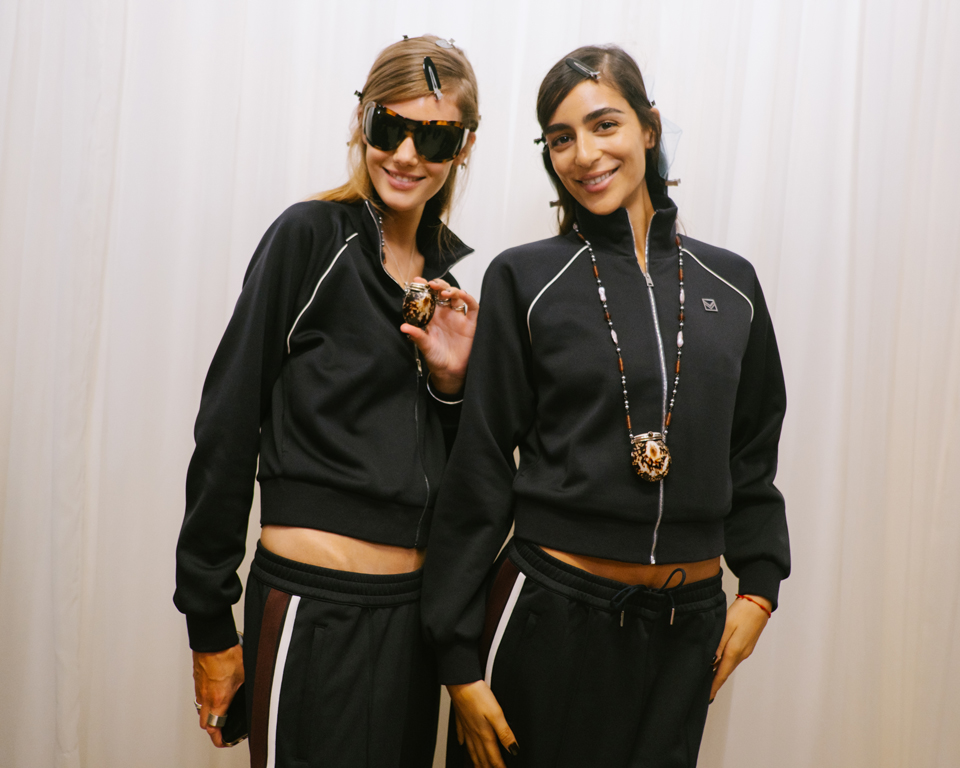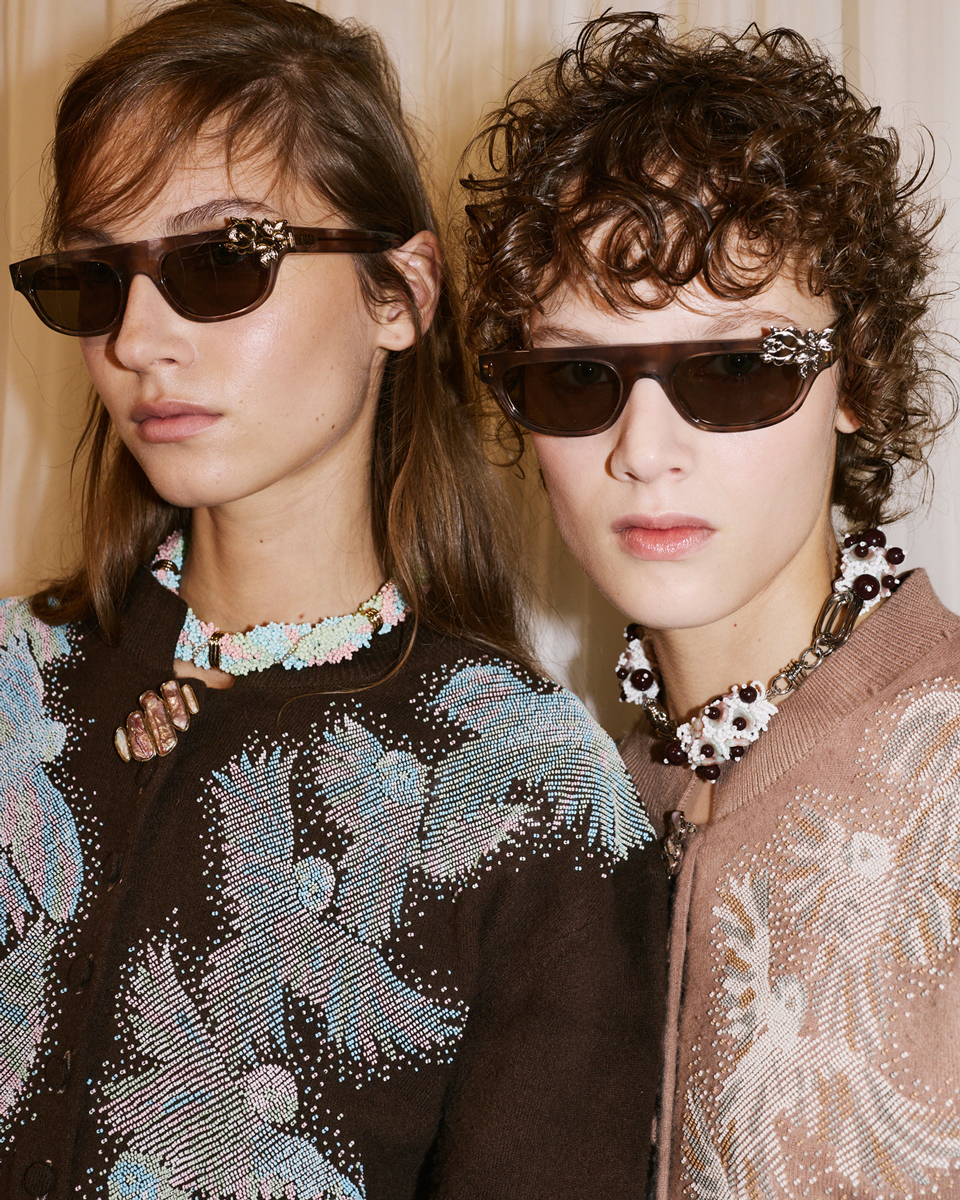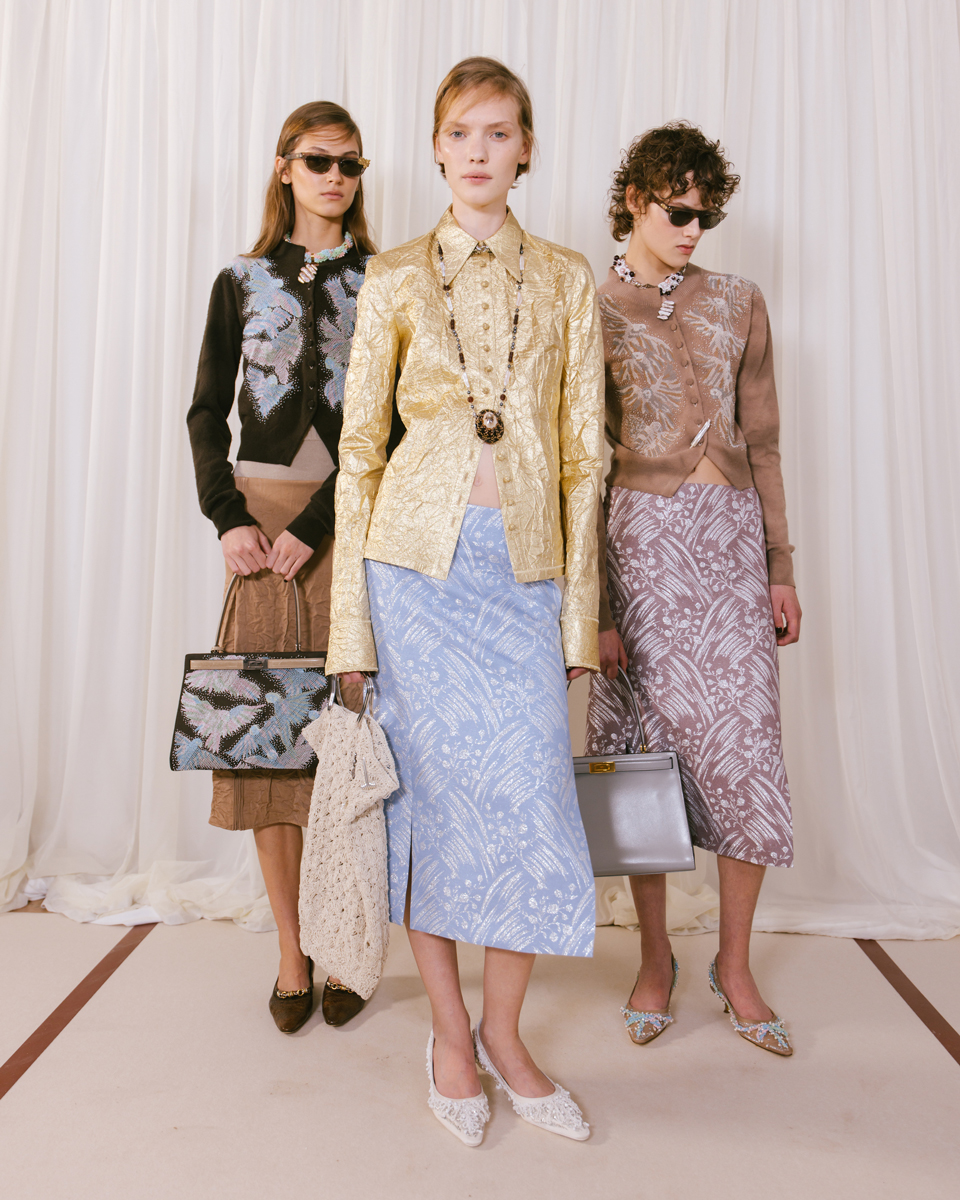The Queen of ‘90s Fashion
A conversation with designer Anna Sui on the occasion of her new Rizzoli book.

Once upon a time in the ‘90s, New York Fashion Week was an organic convening of designers, models, actors and artists. Influencer marketing didn’t yet exist, at least not in its current iteration—you were likely invited as a friend of the designer, rather than being paid to sit in the front row. And there was no show in town like the Anna Sui show.

Sui’s shows were one of the hottest events on the social calendar, where you could sit alongside Sofia Coppola and Marc Jacobs and watch supermodels Naomi Campbell and Linda Evangelista. The evening might end with a table-hopping dinner at Balthazar, followed by clubbing at Danceteria.Born and raised in the suburbs of Detroit, Sui decided she wanted to become a fashion designer at the age of four. She credits her work ethic to her father, a businessman, and her early exposure to fashion to her mother, who taught her to sew. After high school, she moved to New York to attend Parsons, where she joined the creative cultural underground scene.Since her runway premiere in 1991, her work captured the femme-meets-grunge spirit of the decade. Many of the styles we consider quintessentially ‘90s, like sheer silk dresses and ditsy floral babydolls, were popularized by Sui. She had an intuitive understanding of how women wanted to dress, and the tension that comes with inhabiting multiple personas. To be an Anna Sui girl meant that one day you could be a California hippie chick who went to Woodstock, and the next, a London punk rocker with sparkly eyeshadow and metallic microshorts.This multitude of sartorial alter-egos is a direct reflection of the way Sui fluidly immerses herself within subcultures around the world. She is a prime example of the mythical globetrotting aunt who brings back antique knickknacks from Parisian flea markets and turquoise cuffs from Southwestern ranch towns. Perhaps this explains the designer’s enduring appeal across multiple generations. A little edgy, a little romantic, but always infused with the patina of a life well-lived. An Anna Sui piece is catnip for anyone who appreciates glamour.Earlier this summer, I interviewed Sui about her upcoming Rizzoli book, , which chronicles her stories and never before seen photos from old runway shows. We met over a video call, two bobbing heads with matching jet black bangs (hers freshly trimmed the night before), and talked about what made ‘90s fashion so magical.

Hi Anna! It’s such a treat to chat today. You are one of my all-time fashion heroes.I’m wearing one of your old pieces, I’m not sure if you recognize it. It’s this red and white polka dot babydoll dress.So your new book, The Nineties, is coming out this month. How did the idea for this book first come about?Where are you noticing that yearning for the ‘90s? Are there any examples that stand out?The format of the book is interesting, because you include contributions from other ‘90s icons like Marc Jacobs, Sofia Coppola, Linda Evangelista, and Christy Turlington Burns. I was like, this is my dream dinner party guest list. How did you approach these specific people to be a part of your book?Sounds like these are lifelong friendships that have lasted decades. Do you reminisce about the old days together?Your runway shows were such a big part of the ‘90s and 2000s fashion zeitgeist. When you’re designing today, are you conscious of your legacy? Do you self-reference your own archives?
Thank you, it’s nice to meet you.Yeah, I do. I’m glad you have that piece. It’s a nice one.My friend Ileen Gallagher wrote the book. We were talking and she said, “Would you ever want to do a book? I could introduce you to the Rizzoli team.” I’ve had two books, one by Andrew Bolton that was a chronology of fashion shows. The second one was by Tim Blanks and we did it for my exhibition, The World of Anna Sui.So we thought, well, how can we make it different? Since there’s been such a buzz and a yearning for the ‘90s, we decided to do it on the ‘90s.I have some nieces that are all in their twenties, and they’ve been showing up at Christmas parties and family holidays wearing their mom’s clothes from the ‘90s. They say, “Oh, Auntie Anna, you should revive this, you should do this one again.” And a few years ago, Marc Jacobs asked me to redo my grunge collection when we had my exhibition here in New York. Then, Opening Ceremony asked me to do 10 pieces from my archives, and they chose all pieces from the ‘90s.I just see so much Anna Sui on all the resale sites and it sells so fast. There’s a lot of pieces that are very collectible, like the T-shirts and the runway styles. So I thought, well, there’s a big interest in all this. I want to show how genuine it was back then, how it wasn’t such a big business. People weren’t being paid to be sitting in the audience. Maybe the model was dating one of the Hollywood actors, or I went to see a concert and invited the band to my show. It was just a group of friends that enjoyed the same music and clubs and restaurants.It was Ileen who did the interviews, but she asked me initially who she should talk to. Those were the people that I spent time with in the ‘90s. I got to know Sophia because her friend Donovan modeled in my show. And when I went out to LA, they convinced me to open a store. I would see them all the time. We’d go to dinner or go to each other’s houses. Now Sophia lives in New York, so I see her a lot.Same with Marc. I didn’t really know him that well, but then we started being in the same social situations and we decided, well, why don’t we just go to these events together? Then we started freelancing at the same time together at the same company in Italy for a couple of years.Christie did a lot of my early shows until she became exclusive at Calvin. But I had known Christie even before that, along with Naomi and Linda, because Steven Meisel was photographing them a lot. I would go to the studio or they’d come over to my house. So there was already a friendship before we even started working together.It was such an exciting time and we were all going to the same dinners and the same restaurants. Fashion Week was much more intimate. It was pre-cell phone and pre-internet, everything was word of mouth and you didn’t miss a thing. You were always connected that way. If you went to this restaurant, you were going to run into 10 to 20 people that you knew and table-hop and start talking.We never did, up until when we had to recreate those pieces for Opening Ceremony and the grunge pieces for Marc. We had to dig through boxes and find those old patterns. The sad thing is, a lot of the fabric companies that I originally used were American-made fabrics, so it was hard to find substitute fabrics for what we did in the ‘90s.Anyways, people started requesting pieces. We got calls from Olivia Rodrigo wanting to wear the babydoll dresses, which appeared in the Metropolitan Museum two exhibitions in a row. Suddenly, all of those things were in demand. We made the fabric again for the babydoll dresses, but in other cases, we had to find substitutes.Once that started rolling, so many stylists were asking us, “Can you do this? Can you do that?” They’d send pictures from the ‘90s runway shows asking if we could recreate it.

Yeah, there's a resurgence of nostalgia for your archive pieces, especially among Gen Z. How do you feel about it?I saw that photo, it’s the green dress right?Let’s talk about vintage. You’re a lifelong thrifter—how has the culture of vintage shopping changed since the ‘90s?Is New York still a good vintage town?
It’s been really exciting to see a whole new generation wanting to wear the clothes. My niece Chase [Sui Wonders] just wore a bunch of my stuff from the ‘90s and 2000s for the promo of her TV show, . It’s funny because my mom saw the picture before any of us, and she said, “Isn’t that your dress Chase is wearing?”Yeah. It’s kind of like a serape, kind of a square dance dress.Vintage has changed since I first started collecting. I would look for pieces that showcased craftsmanship and textiles. But now, I think people are searching for the holy grail, like the Prada fairy bag. It’s about the specific collection and coloration you want. That has made vintage even more special and way more desirable.It’s not what it was. Back then we had the most incredible flea market ever, ever, ever.There’s a picture of it in the book where I’m shopping with my friends, Paul Cavaco and Tim Schafer, and we would go every Sunday like church. There you would run into so many people from the fashion world, the entertainment world. You’d see Yves Saint Laurent, Catherine Deneuve.It wasn’t a matter of if you would find anything, it was a matter of what you could afford and how much you could buy. I furnished all my stores from the flea market. You would learn so much because all the vendors were knowledgeable. They would tell you who designed what, and how they bought it. It was always such a great social gathering.Little by little, because of economics, those parking lots got sold off. They built these big apartment buildings, so it got condensed to just this parking garage for a while, then they sold the parking garage. So now there’s just a parking lot, but it’s just not the same anymore.

Do you still shop vintage and secondhand?What platforms do you use?I’m curious about your saved searches! What are you on the hunt for right now?You mentioned seeing your own pieces on resale platforms, what’s that like?
Mostly online.Sometimes the RealReal, a lot of eBay, a lot of Etsy, depending on what I’m looking for. I usually go on a binge and have to go on all those platforms. I’ll make a compilation of what’s offered and then go through it and decide what I’m going to buy.Well, I ended up buying one of the Prada fairy bags, which I just love. I was searching for something this weekend…I have to think of what it was. Let me look at my phone.Okay, so there’s a couple of things. I love Bakelite. There’s a woman that does the Manhattan Vintage Show, and she has these bakelite beads. And I thought, let me see if I can find them in different colors.Of course, I’m always looking for the perfect Chanel tweed bag. There’s one that I keep going back to that’s unattainably expensive. It’s from the Chanel Egyptian collection. It has the most beautiful colors, but it’s like $10,000. So it’s like, okay, someday.What’s really exciting to me is when I find a piece from the ‘90s, a piece from a runway show. Sometimes I’ll even buy it because I think I don’t have that in the archive anymore.

Really? I can’t believe Anna Sui herself is in the eBay bidding wars with the rest of us.Your work has always been heavily informed by subcultures, like the California beatniks and London punk bands. But IRL subcultures don’t exist the same way they did in the ‘90s, everything’s so Internet-driven now. Curious to hear your thoughts on that.Tell me about the zine/DIY feel of the book. You include all these scans of old business cards, handwritten notes, Polaroids, magazine clippings. I was struck by how much stuff you had saved. What was the process like, digging up old memorabilia?
Yeah.Well, this weekend I was binging , and it was just fascinating to see this whole youth subculture going on. I mean, I’ve been to New Mexico, but I didn’t come across any teenagers there. I was in Phoenix a couple months ago for the opening of my exhibition show at Phoenix Art Museum, so there is that influence going on. I am thinking about the Southwest for my spring collection. That’s why I found this TV show so fascinating. Whoever did the costumes for the show is brilliant.What’s really different about this book is that my father and my brother took pictures during all those shows in the ‘90s. So a lot of the pictures are from a different perspective, from sitting in the audience. And there’s some backstage photos that have never been seen before. It’s a little more intimate.You’ll see the dresser cards, which I saved through the years. I just would pack 'em up and put 'em in a box, so we dug those all out. You really get a bird’s eye view of how the collections were planned. And a lot of the handwriting is my handwriting—notes and sketches that were done on the backside of the accounts receivables paper.Once I finished a show, I would file everything in a drawer or in a box. So it was hard to find everything, but I kept slowly unearthing things or looking in the bottom of a drawer and finding it. It was fun to see what I did save, like all those Polaroids and notes and the lists of music. I think it helped to tell the story.

Finally, what’s the one thing you hope readers take away from the book?
I hope that people see the simplicity of the ‘90s, and the genuine way we related to each other and even how we promoted ourselves. Fashion was not the big business that it is today. There was much more support within the industry. And the infrastructure of department stores and the media was all there to help.And I’m thankful to everyone that supported me through all those years and helped me, because I built my business myself. I didn’t have big backers. I feel really fortunate that I was able to live that period and survive it, because nowadays it’s much more difficult.
 Spring/Summer 2026: The Warmup The Tory Sport tracksuit is a brand tradition – a comfortable and chic coordinated set for models to wear backstage before the show. It’s the perfect uniform for chatting, lounging and, of course, having your hair and makeup done. This season it was in navy – a retro, shrunken track jacket and perfectly slouchy wide leg pants with contrast side stripes. Before donning the delicate pumps and sandals from the collection, every girl sported the Field sneaker, our new low-profile style that’s a fall must-have.
Spring/Summer 2026: The Warmup The Tory Sport tracksuit is a brand tradition – a comfortable and chic coordinated set for models to wear backstage before the show. It’s the perfect uniform for chatting, lounging and, of course, having your hair and makeup done. This season it was in navy – a retro, shrunken track jacket and perfectly slouchy wide leg pants with contrast side stripes. Before donning the delicate pumps and sandals from the collection, every girl sported the Field sneaker, our new low-profile style that’s a fall must-have. 
